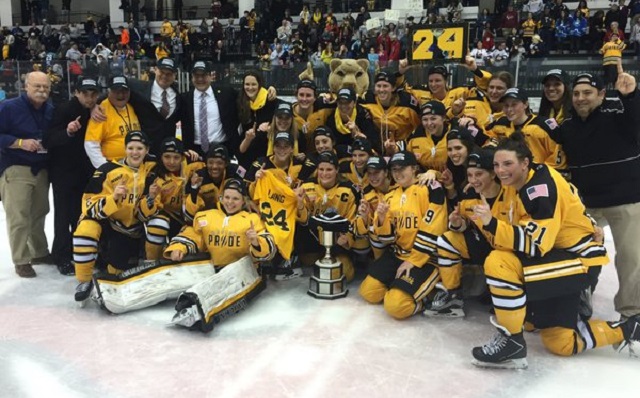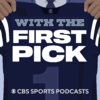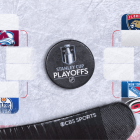
The historic first season of the National Women’s Hockey League, the first paid professional league for women in North America, came to an end Saturday night as the Boston Pride claimed the league’s first title. Led by U.S. Olympians Brianna Decker and Hillary Knight, the Pride became the first team to hoist the Isobel Cup after sweeping the Buffalo Beauts in a best-of-three series.
The series, held at the New Jersey Devils’ practice facility in Newark, had some drama in Friday night’s Game 1, as it ended with Knight scoring on a penalty shot in overtime. Saturday night’s decisive Game 2 was a little less dramatic, but just as tightly contested. The Pride earned a 3-1 win over the Beauts to claim the first title in the league’s history. Doesn't Boston have enough championships these days?
History has been made #ThePack #14Strong #FirstChampions pic.twitter.com/gJ6JHBnxUi
— NWHL (@NWHL) March 13, 2016
The Isobel Cup, which was named after the daughter of Lord Frederick Arthur Stanley and developed in partnership with the Hockey Hall of Fame, was a fitting award for the championship team. The inscription on the trophy reads: "This Cup shall be awarded annually to the greatest professional women's hockey team in North America. All who pursue this Cup, pursue a dream; a dream born with Isobel, that shall never die."
The Olympic gold medal will always be the top prize in women’s hockey, but a professional championship is truly a new height.
“It felt like the Stanley Cup,” Decker, the MVP of the playoffs, said of hoisting the Isobel Cup after the game. “That’s exactly what we were going for with women’s hockey. It’s fantastic.”
It was a special moment for the Pride, which is a team that has been through an awful lot this season. They are the team former Princeton University standout Denna Laing was playing for when she became paralyzed after an awkward fall into the boards at the Women’s Outdoor Classic earlier in the year. The hockey community has really rallied around Laing since her injury, with the NHL spearheading massive fundraising efforts to help her in her recovery.
Laing could not make it to New Jersey to celebrate with her team in person, but she was a big part of the celebration. The team held up a wood cutout with her No. 24 as they posed for the championship photo with the Isobel Cup, which was adorned with Laing's hat. During the celebration, they also used FaceTime to make sure their teammate didn’t miss out on this great night for the Pride.
Best moment for me, someone said "Denna is here!! Denna is Here!!" and there you were, celebrating ! @dlaing14 pic.twitter.com/Iz5MOaEPzq
— Troy Parla (@TroyParla) March 13, 2016
“She meant everything to us,” Pride defenseman and U.S. Olympian Kacey Bellamy said of Laing after the game. “She’s been with us every step of the way and we know she’s with us right now.”
The four-team league still has strides to make, but its existence at all has been an important development in women’s hockey. There’s no doubt that the league has helped create not just exposure for women’s hockey, but sustained exposure. For a sport that typically only gets attention from the hockey world at large every four years at the Olympics, this inaugural season brought the women’s game to a larger audience than it would have found otherwise.
Additionally, the league has provided a U.S.-based outlet for the top women’s players to continue sharpening their skills and playing meaningful, competitive hockey beyond their college years. It also attracted players from all over the world, which will only help those players' national teams in the future, too. Previously, the Canadian Women’s Hockey League and some other scattered women’s teams were the only places to play for top competitors, but those would be unpaid options. Now there's a place that is paying players and providing that high level of hockey they need to continue in their post-collegiate development.
There are still major hurdles to overcome for the league as it navigates the always difficult financial roads of professional sports. No matter the gender of the athletes, pro sports league and teams are difficult to sustain in general.
The league also has an incredibly small geographic footprint, which limits growth potential in the short term, but there remains hope for expansion. That takes more money, though, and the league will have to be careful not to try to expand too rapidly, which only increases the long-term risks.
The women in the NWHL make modest salaries and get a cut of their jersey sales, so they’re certainly not getting rich. That becomes a concern for player retention, but given the league's almost instant credibility from a competition standpoint, they should be able to fill the gaps with the latest round of graduates from top college hockey programs.
The sustainability concerns will always be there. The league has been relatively quiet about its finances, which have reportedly come mainly from private donations. They are starting to pick up corporate sponsors, which is helping them grow, but they still have to battle the stigma of being a niche in a niche sport and that relatively small geographic footprint to generate that big-time corporate backing.
There also is competition for players with the CWHL and there has appeared to be animosity between the two leagues. It prevents the best players in the world from being under one roof, which prevents the product from being as good as it can be (even if it's still pretty darn good). At some point, however, the two leagues are either going to have to coexist or merge if they want to take this to the next level. A championship series between the winners of two leagues could be a great tool for exposure and cooperation, though.
The NWHL did not have a perfect first season by any means as there were some stumbles here and there, but that's to be expected for a fledgling organization. You have to give credit to commissioner Dani Rylan for deciding to make this all happen.
People have surely thought about it before, but no one actually acted. Even NHL commissioner Gary Bettman was on record as having explored the possibility of women's pro hockey and finding it to be "not viable." That comment was from an interview with Al Michaels just two years ago. Now the league exists and if they can prove at least the potential for viability, perhaps the NHL steps in and provides some additional support one day.
There are more girls playing youth hockey now than ever before and this league has a chance to grow the game even further. The best women’s players in the world are being told that they deserve to be paid for what they do, which is another big step even if it's not a lot of money. If you watched any bit of the Isobel Cup playoffs, you saw a good hockey product. The players in this league are committed to that and it shows. It was, by many measures, a successful first season.
The challenges ahead for the NWHL are many, but they also used to say that there would never be a paid women’s professional hockey league in this country.





















